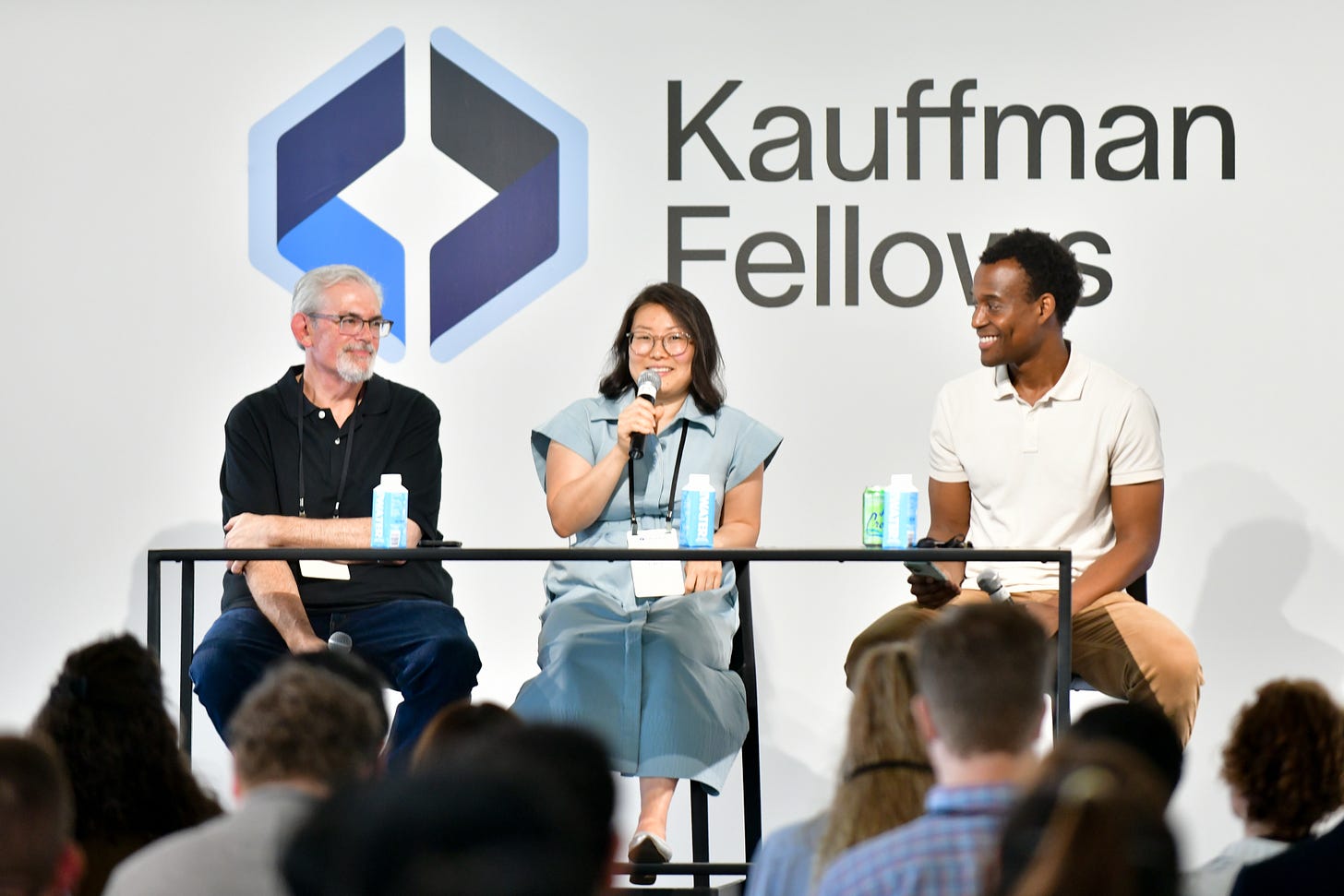What’s Actually Venture-Backable Today?
The 21st Bulletin Edition provides a new lens on moats, teams, and the menus LPs are ordering from.
What’s Still Working?
We’re living in a venture capital reset.
Not a crash.
Not a boom.
But something stranger: a recalibration in progress.
Everyone’s asking:
What kind of firm still works? (essay #1)
What kind of founding team still wins? (essay #2)
What kind of VC team can still execute? (essay #3)
This 21st edition of the School Bulletin is my attempt to answer those questions, not from a place of dogma, but from what I see every day in LP meetings, founder check-ins, and anecdotes from real operator journeys.
Because the old answers won’t cut it.
Today, wisdom matters more than frameworks.
Service matters as much as access.
And knowing what’s really venture-backable? That matters more than ever.
Like always, what you are about to witness is my thoughts. Just what I was feeling at the time.
Essay 1: Appetizers, Entrées, and Michelin Star Rounds:
What is venture-backable in 2025? Depends on what’s on your menu.
A GP friend recently emailed me about the Power Law:
“The era of ‘one mega win covers 19 losses’ is over”
It stuck with me.
Not because I agreed—
But because I couldn’t stop thinking about why they said it.
Venture capital today isn’t just one game played a thousand times.
It’s a full-blown tasting menu.
And the hard part is, most of us don’t realize we’re serving different meals.
Some firms are offering appetizers—easy to digest, a light lift, and a solid return.
Some are reliable entrées—growth equity-style, with a line of sight to profitability, healthy ownership, and clear exit lanes.
And some are going full Michelin star—swinging at rare, outlier outcomes that may not be understood today, but will define tomorrow’s S&P.
That’s not a hierarchy.
It’s a reality check.
And it’s forcing GPs—and LPs—to ask a question that’s been hiding in plain sight:
What is actually venture-backable today?
We Used to Know the Answer (Or Pretend To)
Back in the “growth at all costs” era, anything that moved up and to the right—fast—in a huge market was venture-backable.
Unit economics? Optional.
Liquidity timeline? TBD.
The only real question was: Could this be huge despite having a limited market share?
Now we’re living in the long shadow of that moment.
Public markets are more skeptical.
LPs are slower to re-up.
And there’s a growing split between what sounds like a venture story and what actually performs like one.
Power law hasn’t gone away—but the paths to it have multiplied.
I’ve seen three big schools of thought emerge lately:
Non-consensus to consensus:
The classic contrarian bet that becomes obvious in hindsight. Still works—but requires conviction, long hold periods, and differentiated sourcing.Early into the consensus:
Betting early on seasoned founders or hype-cycle sectors that blue-chip firms will follow. Success here is about access and positioning, not contrarianism.Alpha via profitability and precision:
Not everything is a rocket ship. Some are well-built engines. These are cash-flowing, acquirable, or niche-dominant plays that don’t need unicorn scale to deliver outsized returns, especially if you have a large group of your portfolio providing these outcomes.
Note: many forget the second portion of the Golden Rule of the Power Law. You have to not only select the right companies but also own as much in those companies as you can.
What’s on Your Menu?
That question matters more than ever.
Because today’s LP isn’t just choosing between firms—they’re choosing between categories of venture:
Are you offering repeatable, capital-efficient businesses with clear M&A paths?
Or are you promising the next breakout company that nobody sees coming?
Or are you selling exposure to a wave (AI, space, biotech) with asymmetric upside?
And that’s before you even get to fund construction, reserve strategy, or value-add claims.
As a GP, if you don’t know what you’re cooking…your LPs sure won’t.
And if you're an LP, you better know if you're buying scrambled eggs or a 14-course omakase.
What I’m thinking of doing next on this subject:
Sketching out a menu matrix—pairing different GP venture strategies with the LPs best suited for them. (Because yes, you can be a $40M brunch fund with alpha baked in. Or a Michelin-style dinner that's only for institutions with taste—and time.)
Until then, ask yourself:
GPs, what kind of venture are you selling?
And LPs, what kind of venture are you hungry for?
Essay 2: The Wisdom Worker Era
Why experience, learning velocity, and contextual awareness are the next superpowers in venture
For most of the modern tech era, we’ve been obsessed with knowledge workers—those who process data, move information, and make decisions from clear inputs. In venture, I came up in that era. You’d read the blog posts, build the market map, memorize the frameworks, and chase the companies. Everyone was using the same data, playing on the same field.
But I think we’ve entered a new phase now. One where context matters more than content. Where judgment beats memorization. Where velocity isn't just speed—it’s wisdom in motion.
We’re in the Wisdom Worker Era.
It hit me recently while reflecting on how much AI tools like Fathom, Otter, and Granola have changed my approach to synthesizing meeting notes. I no longer have to remember everything. Now I can prompt my notes: “What insights keep coming up?” “What dots connect across my four work streams that will best position Stresswood’s launch?” I used to just chase takeaways. Now I chase meaning.
Wisdom workers are different. They don’t just collect knowledge—they sense when paradigms are shifting. They know how to apply analogies across domains. They recognize the subtle rhymes of history. As my friend Colin from Lobby Capital once described, they’re tuned into the “perishable insights”—the ideas with value before they become consensus.
That’s where learning velocity comes in. The speed at which you can not only absorb new information but also apply it before the market catches up. That’s what drives arbitrage. That’s what makes an operator or investor special.
This shift has implications that extend beyond productivity hacks.
I think it’s going to reshape how we think about age in the venture space. If we’re now entering a market where experience, pattern recognition, and contextual awareness matter more, then the value of “gray hairs” around the table increases. As an entrepreneur, I learned that lesson the hard way. Having seasoned advisors—people who could help you skip steps—would’ve saved me pain and capital. Perhaps we don’t see older founders in large numbers, but we’ll certainly see them as key advisors, operating partners, and investor allies.
For Stresswood, this era challenges us to think about who we back and who we build with. It’s not just about generational diversity on a cap table. It’s about whether the founders we back can surround themselves with the kinds of operators and advisors who are exceptions—those who bring real wisdom, not just résumés. It’s also why the GPs at Stresswood will need networks that bridge generations, communities, and sectors. If you can’t cross those lines, you’ll miss the context that turns insight into edge.
This is the Wisdom Worker Era. And it’s not about having all the answers—it’s about knowing where the real questions live.
Essay 3: The Industry of Favors (and Why I’m Betting on Nexus Outsiders)
A couple of weeks ago, my friend Katie from Bicycle Capital said something that stuck with me: “Venture is an industry of favors.”
At first, it rang true—and also a little icky. It reminded me of the dynamic you see in bad sales: all take, no give; performative relationships driven by keeping score.
But then I thought back to something I learned from the book The Unsold Mindset: we often misjudge what good sales—or good relationship-building—actually is. The best leaders, and the best VCs I know, are often selling without calling it that. They serve. They connect. They invest in others first.
So when I thought more about Katie’s point, here’s where I landed: venture is an industry of favors—but it’s up to us whether we make it an industry of service.
At its worst, favors in VC can devolve into transactional echo chambers—cliquish circles that trade introductions and access with no intention of serving the founder or the LP. But at its best, favors are just the currency of service. They flow naturally when you do what you do well, when you serve in ways that are authentic to you, not from a social-climbing playbook.
For me, this shows up in the kind of relationships I aspire to build through Stresswood. I want to be a connector of networks and a bridge across ideas. In a world where technology, markets, and industries are converging faster than ever, the next great players in venture capital won’t be the ones who sit inside a single mafia or echo chamber. They’ll be nexus outsiders—people who bridge worlds, spot patterns others can’t see, and give before they ask.
And yes—this will still involve transactions. That’s not the enemy. The goal is to make those transactions flow from a place of service, not self-congratulation.
So as I build, I’m looking for others who see it this way, too. People who tinker, help, and connect—not because they have to, but because that’s who they are.
Venture is an industry of favors. The future of the industry will belong to those who serve.

Closing: With Gratitude
Thanks for making it to the end of another School Bulletin.
This edition marked another milestone—a deeper look into how I think about the investing landscape, how I see teams form around opportunity, and how I plan to keep showing up: with clarity, conviction, and service.
If you'd like to partner, build, or simply exchange ideas, my door is open. And if something in here resonated, I’d be honored if you passed it on to someone navigating this cycle with curiosity and courage.
— With gratitude,
Earnest Sweat
General Partner, Stresswood



